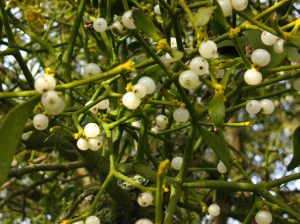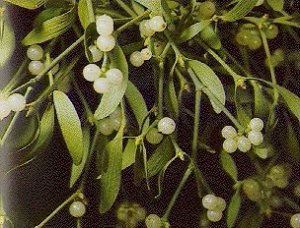
Mistletoe
The name was originally applied to Viscum Album(European Mistletoe, Santalaceae), the only species native in Great Britain and much of Europe. Later the name was further extended to other related species, including Phoradendron serotinum (the Eastern Mistletoe of eastern North America, also Santalaceae). European Mistletoe is readily recognized by its smooth-edged oval evergreen leaves borne in pairs along the woody stem, and waxy white berries in dense clusters of 2 to 6. In America, the Eastern Mistletoe is similar, but has shorter, broader leaves and longer clusters of 10 or more berries. In the United States, Phoradendron flavescens is commercially harvested for Christmas decorations, as is Viscum album in Europe.
Mistletoe plants grow on a wide range of host trees, and commonly reduce their growth but can kill them with heavy infestation. Viscum album can parasitise more than 200 tree and shrub species. Almost all mistletoes are paracites.(A parasitic plant is one that derives some or all of its sustenance from another plant.), bearing evergreen leaves, and using the host mainly for water and mineral nutrients.
Most mistletoe seeds are spread by birds, In Europe mainly by the Mistle Trush.
Mistletoe was often considered a pest that kills trees and devalues natural habitats, but was recently recognized as an ecological keystone species, an organism that has a disproportionately pervasive influence over its community. A broad array of animals depend on mistletoe for food, consuming the leaves and young shoots, transferring pollen between plants, and dispersing the sticky seeds. The dense evergreen “witches brooms”formed by the dwarf mistletoes (Arceuthobium species) of western North America also make excellent locations for roosting and nesting of the Northern Spotted Owl among others.
European mistletoe, Viscum album, figured prominently in Greek Mythology. In cultures across pre-Christian Europe, mistletoe was seen as a representation of divine male essence (and thus romance, fertility and vitality), possibly due to a resemblance between the berries and semen.
Mistletoe is commonly used as a Christmas decoration, though such use was rarely alluded to until the 18th century. Viscum albumis is the Mistletoe used in Europe whereas Phoradendron serotinum is used in North America.
According to custom, the mistletoe must not touch the ground between its cutting and its removal as the last of Christmas greens; it may remain hanging through the year, often to preserve the house from lightning or fire, until it was replaced the following Christmas Eve. The tradition has spread throughout the English-speaking world but is largely unknown in the rest of Europe.
According to Christmas custom, any two people who meet under a hanging of mistletoe are obliged to kiss. The custom may be of Skandinavian norign and is found in history as early as 1820.
“The mistletoe is still hung up in farm-houses and kitchens at Christmas, and the young men have the privilege of kissing the girls under it, plucking each time a berry from the bush. When the berries are all plucked the privilege ceases.”
Mistletoe leaves and young twigs are used by herbalists, and it is popular in Europe, especially in Germany, for treating circulatory and respiratory system problems. Use of mistletoe extract in the treatment of cancer, however clinical evidence does not support claims of anti-cancer effect for mistletoe extract.
The sticky juice of mistletoe berries was used as adhesive to trap small animals or birds. In South Africa it is called “Bird lime” in English and voelent in Afrikaans. A handful of ripe fruits are chewed until sticky, and the mass is then rubbed between the palms of the hands to form long extremely sticky strands which are then coiled around small thin tree branches where birds perch. When a bird lands on this it gets stuck to the branch and is then easy to catch by hand.
Lamber de Bie.




[…] Mistletoe Under Pillow […]
[…] Mistletoe November 2010 1 Like on WordPress.com, 5 […]
[…] Mistletoe Under PillowThe only women of eire wait frantically for that New Year’s evening since it is the evening that literally brings them the romance of the existence. They place mistletoe leaves under their pillow wishing to trap their husband to be. It’s also supported Irish culture it enables them to eliminate misfortune. […]